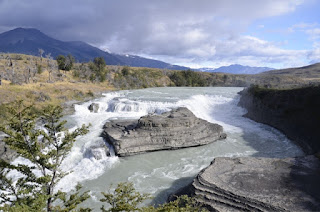By far the most impressive sight in the area is the Torres del Paine National Park which provides some of the most magnificent walking in the world. We would have liked to undertake the 6 day "W" hiking circuit that fellow guests in our lodgings had just completed, but we contented ourselves with a day trip into the park.
First stop is a cave just outside Puerto Natales where, in 1896, a German born landowner started a furore when he found the hide of an animal that was soon declared as being from a giant sloth. The piece of skin was so fresh that an international hunt was started to find a living specimen. The Daily Express newspaper in England sponsored a scientific expedition. In fact the skin was over 10,000 years old but the dry atmosphere in the cave had preserved it perfectly. This didn't stop many sightings of the beast being reported, so we felt compelled to pose in front of our own positive sighting.
 |
| Guanaco |
It is nearly 150km to the Park entrance along a rough dirt road (there is no nearer base point). Along the way we spotted an armadillo. These are extremely rare in the south, but more common in the north where the shells of dead animals are used to make guitar cases. We also spotted six condors circling high above, and a number of wild guanacos. The gauchos here move their livestock from pasture to pasture by horseback.
Once inside the Park the skyline is dominated by the Cuernos del Paine (horns of Paine), twisted pillars of grey granite, dusted with snow and rising into a sky of billowing grey clouds. The famous Torres (Towers) are even more difficult to see because of cloud cover. In fact the weather can change here in an instant. The prevailing wet conditions coupled with the almost constant high winds, regularly see Torres and its adjacent high peaks covered in a maelstrom of moisture laden, boiling storm clouds. So it was for us in the morning.
The strong winds are known locally as Escolado de Dias, or God's Broom. Any visitor climbing high on the mountains is at the complete mercy of the weather gods.
We made a photo stop to admire the waterfalls. Most tourists were oblivious of the owl, perched quietly in a tree beside the viewpoint.
As the skies began to clear we were rewarded with some magnificent views of snow-covered peaks, turquoise lakes and lush valleys.
Our final stop was Lake Grey where we enjoyed a walk along the shore line to observe the Grey Glacier on the far shore, and the many icebergs that had broken off from the glacier and floated across the lake. On the long journey back our driver possessed considerable off-road rallying skills, controlling the slides beautifully as we rounded corners at suicidal speeds. (Actually it was quite hairy at times).







No comments:
Post a Comment